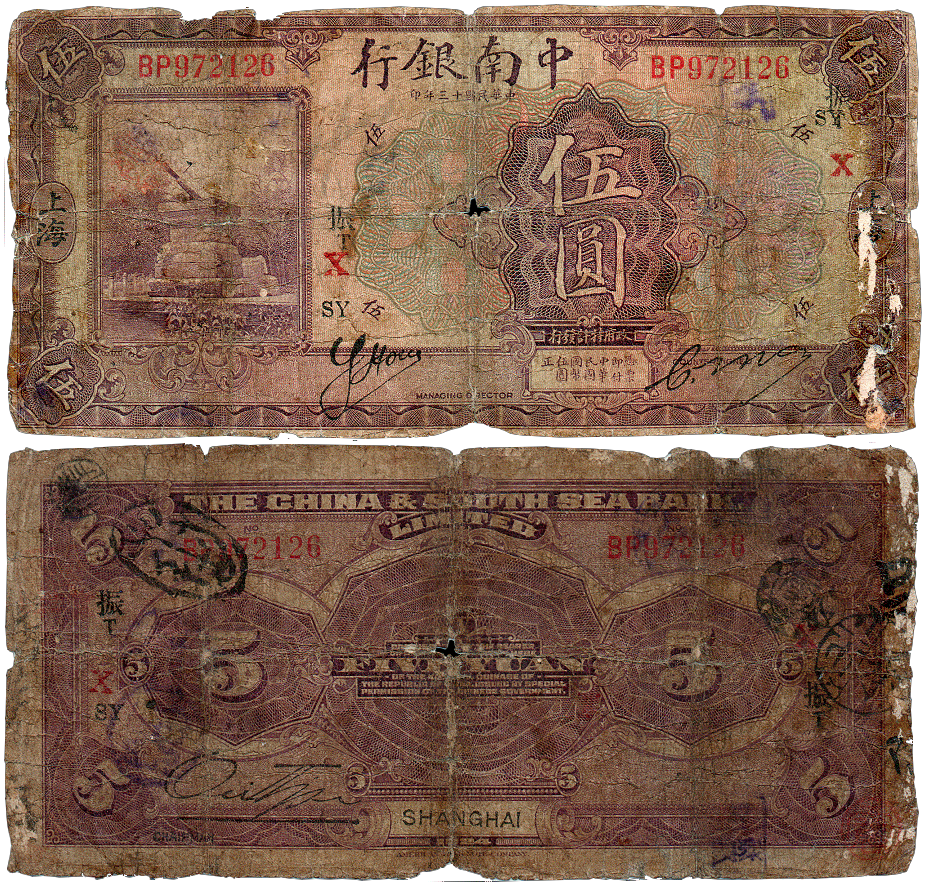Updated October 15 2017
The Overprints on the currency of the Central Bank of China and other government banks
Most collections of Chinese currency will include examples of notes carrying a variety of overprints: Chinese characters, Latin letters, numbers and even logos; sometimes in combination. The exact purpose of these puzzles many.
|
Their appearance, and subsequent disappearance, partly relates to the currency reforms of the period, though the practice seems to have had it's origins as far back as 1915.
The Bank of China began forming agreements with private banks and other issuers in which these would circulate marked government notes in place of (or in earlier schemes, in addition to) their own currency issues. Linsun Cheng in "Banking in Modern China" (2003, p163) refers to such a scheme for Shanghai branch issued notes - began in 1915 and involving 22 banks by 1924. In subsequent years similar agreements were made between all the government banks and private issuers to have the latter issue the government currency through their own banking offices in place of their own currency issues. In order to keep track of the issuer and the amount of money they placed into circulation, the notes were overprinted with symbols indicating the identity of the business, and in some cases the specific branch or office of issue. |
|
The practice seems - logically enough - to have come to an end in or around 1935, as this year saw the introduction of currency reforms which in theory restricted currency production to the government banks, rendering this substitution system obsolete. Banks could now only issue the government notes of the Bank of China, Bank of Communications, The Central Bank of China and later the Farmers Bank of China, though some 1935 series Farmers Bank notes issued from 1936 are found with numerical overprints, though these are scarce. That said, many banks continued to issue their own notes despite the regulations; either unofficially - especially with banks beyond government control - or on many occasions through special permission granted via the Ministry of Finance. The Kwangtung Provincial Bank for example continued to issue it's own money up until 1940, and briefly resumed issue in 1949. Some official overprints may have other purposes. The Bank of Communications was involved in the above scheme, however some notes have overprints (a pair of 'H', or 'P') printed in a different manner which may indicate either an earlier phase of the scheme, or a separate system perhaps relating to internal problems: one possibility is that the Tientsin branch notes marked 'P' may actually have been issued in Peking (Beijing), as the Peking branch ceased to issue money in it's own name sometime after 1916, due to political troubles. Finally, some private bank issues appear themselves with overprints for reasons unknown. It may have been a similar scheme in which smaller private banks and businesses agreed to issue the money of a larger private bank. The China and South Sea Bank is one such example of a major bank whose currency issues are often found with officially added numerical and alphabetical overprints. Images: above (top left) Central Bank of China $5 of 1930 (circulated c1933) with Chinese character overprints. (above, upper left) Central Bank of China $1 of 1928 (circulated c1930) with a seal/chop (?) type overprint in archaic script at the left, and a Chinese character at the right. left: The Bank of Communications 10 Yuan of 1914 (issued 1925-1927). below (left) The China and South Sea Bank Ltd 5 Yuan of 1924 with 'X', 'SY' and Chinese overprints (not to be confused with the merchants 'chops'). Below (right) Bank of China 5 Yuan of 1926 with numerical '28' and Chinese overprints. |





